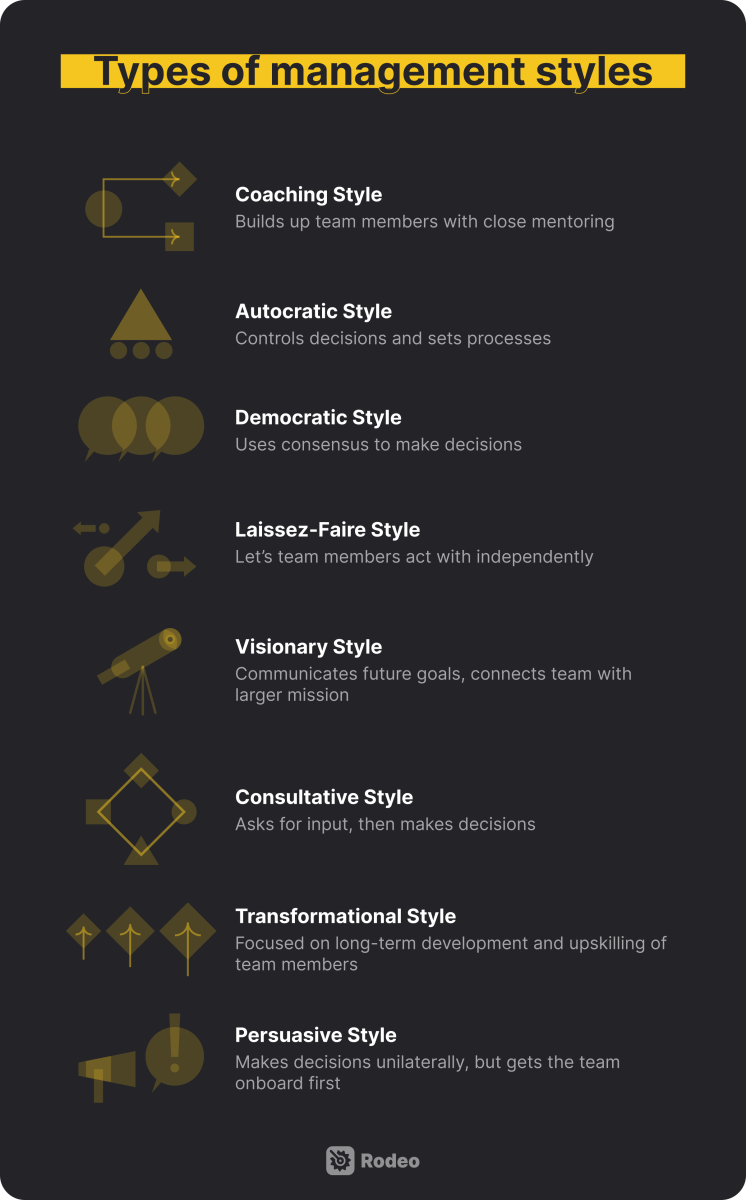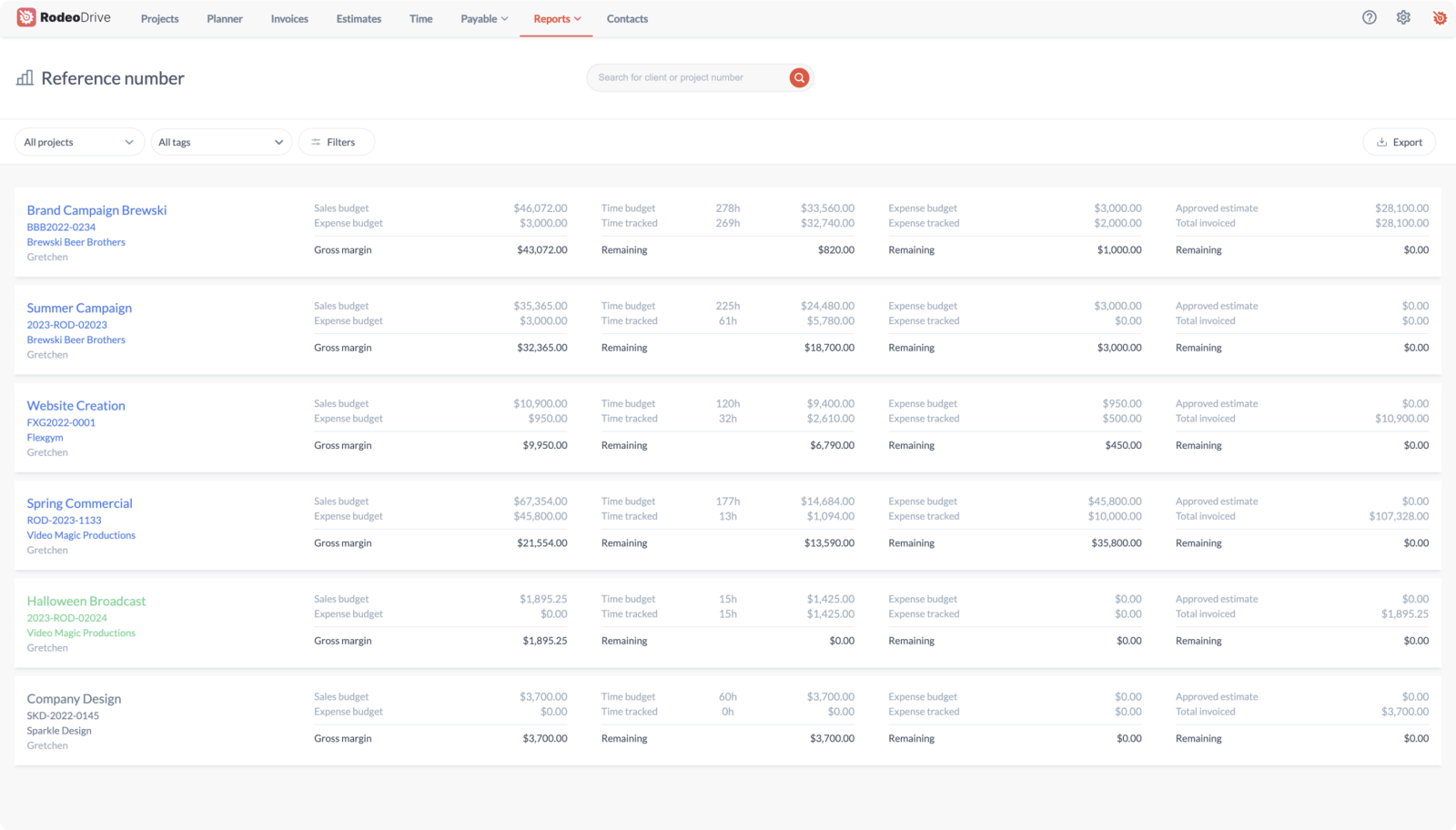8 Types of Management Styles for Effective Leadership
What makes a good boss? Think back on your past experiences and you'll certainly remember authority figures you felt connected to, and others you found challenging to deal with.
Be it teachers, coaches, or supervisors, some leaders just have a way of drawing the best from you. What were the qualities of these leaders? Were they disciplinarians? Hard-nosed? Strict?
Or, were they collaborative, thoughtful, and open to feedback?
Different people benefit from different styles of leadership. While some of us do our best when pushed by a firm hand, others thrive with a lighter touch.
As a leader, understanding different management styles can help you unlock your team's potential. Here are eight styles you can use to sharpen your leadership skills.

What is a management style?
A management style refers to how managers interact with their teams, make decisions, handle roadblocks, and guide the trajectory of projects. They aren’t just limited to the strategies managers use to meet goals, but also include the values and interpersonal dynamics that a manager fosters in a team.
Management has a significant impact on employee engagement and productivity. According to a Gallup study, managers account for 70% of the variance in employee engagement.
Simply put, engaged teams are more productive, and managers play a large role in shaping engagement. That’s why managers should be aware of how their leadership style influences the behaviors of their teams.
Do you encourage a culture of direct feedback? Are your team members comfortable communicating when there are problems or mistakes? How do you respond to setbacks and failures? Do you share accountability with your team, or try to sweep things under the rug? How do you show appreciation when an employee hits a big project milestone?

A lot of it comes down to personality. Every leader has past experiences and deep-seated values which predispose them to certain management styles.
Some leaders value order, so they adopt a detailed and directive style. They lay out meticulous guidelines while closely monitoring tasks. Others care about autonomy, preferring to give their team broad direction while encouraging individual interpretation and feedback.
Of course, leaders can try to adapt their styles. However, management styles can be deeply connected to our distinct personal attributes. This means that to become a more capable leader, rather than changing what you can't, it's better to lean into the best of who you are.
Every manager, with their unique personality and leadership styles, will resonate differently depending on their team, organization, and the nature of the projects they lead. Learning to balance self-awareness with flexibility will usually land you somewhere in the happy medium.
Why are management styles important?
We've established what management styles are. Now, let's get into the specifics of why developing a good management style is important for achieving better management outcomes.
The four functions of management
Planning, organizing, leading, and controlling are the four functions of management. Management styles influence how these functions are carried out as there are different ways to go about each — and they all play an important role in team success. Let’s take a look.
Planning
A manager's first responsibility is to set actionable objectives that align with the organization's larger goals. While team members are the ones who take steps to meet those objectives, managers help bridge the gap between the team’s actions and the organization’s business goals, which requires planning.
A manager with a participative style, for example, might encourage team input in the planning and allow team members to help define objectives. Visionary managers might try to instill the organization's larger mission and goals into their team members, allowing them to see how personal tasks are connected to the bigger picture.
Organizing
Organizing refers to how a manager assigns responsibilities and guides the implementation of plans. Depending on the management style, this can involve more or less involvement from the team.
An authoritative management style might lead to more rigid, top-down organizing. While this might sound bad, it can be effective in businesses that require standardized processes and adherence to rules.
Leading
The function where your management style is most transparent is leading.
Leading comes down to how a manager motivates their people and guides them towards objectives. Are you hands-on in problem solving or do you delegate to your subject matter experts? Which decisions do you make yourself versus which ones do you allow your team to own?
A democratic manager may give their employees input over day-to-day tasks. A transformational manager might lead by providing growth opportunities for their people and cultivating a sense of purpose among them.
Controlling
Controlling is about making sure teams are moving towards planned goals. This involves monitoring performance, ensuring accountability for objectives, and implementing adjustments.

Rodeo Drive’s real-time Projects report to help managers monitor a project’s financial performance at a glance
While controlling seems like it requires an authoritative style, there are other ways managers can approach this function.
A leader with a more laissez-faire or democratic management style might encourage team member involvement in controlling, for example. This might include involving team members in the goal-setting process at the offset of a project so they feel more ownership over project outcomes.
Also read: 12 Ways to Improve Team Accountability [Remote & Onsite]
How the right style can lift team performance
Every management style has strengths and weaknesses. If you're a senior managing a team of recent graduates in a field with very niche rules and regulations, then a mix of hands-on coaching and an authoritative approach is likely to be well received.
But if you apply that same management style to lead a project staffed by veteran creative professionals, senior and well-versed in their different areas of expertise, then that same level of involvement might step on toes.
.png)
Choosing the right management style based on the qualities of your team has the following benefits:
1. Improves Engagement
The right management style can significantly improve team engagement. When leaders tailor their approach to the needs of their team, it fosters a sense of belonging and value.
A participative style, for instance, can help build stronger team bonds by making team members feel heard and respected — leading to more enthusiasm towards their work.
2. Boosts Retention
Employee retention is also directly influenced by management styles. When employees feel understood and see opportunities for professional development, they are more likely to stay with the organization. A supportive, growth-oriented approach like the coaching style can enhance job satisfaction, leading to lower turnover.
Conversely, styles that overlook employee well-being can lead to higher attrition.
3. Enhanced Productivity, Creativity, and Innovation
Finally, the right management style can be a catalyst for innovation. Styles that encourage team participation in decision-making while still allowing autonomy over how tasks are completed are great for fostering a creative work environment.
Democratic leaders might achieve this by encouraging their team to share differing perspectives and ideas and finding ways to turn team member input into active initiatives.
Visionary leaders might spark creativity by presenting challenging yet exciting goals that push their teams to think creatively.
8 types of management styles that nurture successful teams
1. Coaching management style
A coaching management style focuses on employee development. Coaching managers encourage team members to foster new skills and grow professionally.
Coaching managers aim to build their people’s capabilities so that they can better adapt to the organization's future needs.
This might look like sitting down with employees to set personal goals that align with the organization's objectives. These goals are usually challenging yet attainable, pushing employees to stretch their abilities for the sake of long-term improvement.
Coaching leaders also make it a point to regularly deliver constructive feedback. Their transparency enables employees to know where they stand, and understand how they can become their best professional selves.
Strengths:
- Allows for hands-on mentorship
- Helps provide support for challenging employees
- Often perceived as an empathetic and personable style
Weaknesses:
- Time-consuming
- Can cause learning curves that slow short-term team progress
- May pose a retention challenge as team members grow and potentially seek opportunities elsewhere
2. Autocratic management style
Out of all the types of management styles, the autocratic style is probably the most infamous. An ineffective autocrat is a surefire way to have a bad employee experience. Yet, there are cases where an autocratic style can be effective.
Leaders with an autocratic management style like to have the final say. They control the strategic planning process and tend to make decisions on their own, with minimal involvement from their teams. This can speed up decisions, but also lead to bad results in situations where the manager doesn't have enough expertise.
Capable autocratic managers are directive and offer clear instructions. They supervise tasks while offering consistent feedback, helping bring things to standard.
In fields with strict regulations, the rules and processes autocratic managers enforce can help organizations stay compliant. The drawback of the autocratic style is that it dampens team engagement. Additionally, an autocratic management style discourages out-of-the-box thinking.
A risk with autocratic management is having all the eggs in one basket. Autocratic managers often struggle to acknowledge their own mistakes and weaknesses. So, team effectiveness will largely come down to the ability of the manager.
If they're capable, your organization will be able to make quick, effective decisions. If they have blind spots or suffer from one-sided thinking, then those qualities will be magnified since there are no checks on their authority.
While the autocratic style isn't always a bad choice, it has significant drawbacks and should be avoided in most contexts.
Strengths:
- Faster decision-making process
- Clear structure and expectations
- Better quality control
Weaknesses:
- Can breed resentment among the team
- Reduces team innovation
- May harm retention and lower team morale
3. Laissez-faire management style
Laissez-faire management, also known as a delegative management style, is characterized by a hands-off approach that grants a high level of autonomy to team members.
Laissez-faire managers tend to provide minimal direction and oversight, trusting employees to solve problems independently. Strong laissez-faire managers will still take responsibility for results and set time aside to offer constructive feedback. But, when it comes to short-term goals and daily workflows, they trust their people to have a handle on things.
The laissez-faire style is most effective in teams with self-motivated and experienced employees. Senior creative teams made up of domain experts tend to benefit from the freedom that this style offers.
Further, the style’s high degree of ownership over tasks usually translates to a clear accountability structure.
Strengths:
- Allows for employee autonomy and on-the-ground decision-making
- Helps foster a high-trust environment
Weaknesses:
- Managers may lose insight into the team’s daily activities
- Can cause a lack of direction
- Not suitable for inexperienced employees or those who need extra guidance
4. Consultative management style
Consider the consultative management style a balanced approach. It combines elements of democratic management with strong, hands-on leadership.
With this style, managers actively seek input from their team members, encouraging their involvement in the decision-making process. However, unlike purely democratic or laissez-faire styles, the manager retains final decision-making authority.
Managers using this style can create an inclusive, collaborative environment while maintaining a strong leadership presence. For teams, this creates a sense of clarity and direction, while allowing them to feel that management is receptive to new ideas.
The best consultative managers focus on maintaining open lines of communication, staying open to ideas and concerns from team members, and finding ways to incorporate input into final decisions.
Strengths:
- Encourages employee engagement
- Provides structure
- Encourages well-rounded decision-making
Weaknesses:
- Potential for conflict if team suggestions aren't implemented
- Difficult to balance seeking input and exercising authority
- Requires extensive time-commitment from manager
5. Democratic management style
The democratic management style encourages open discussion and collective decision-making. Democratic managers encourage their employees to speak their minds. They value a marketplace of ideas and make sure their people feel heard and involved.
Democratic managers aren't hands-off, however. They're responsible for filtering ideas and ultimately deciding on the best course of action. Occasionally, this means making decisions that don't leave everyone happy.
Strengths:
- Encourages open communication
- Boosts engagement and job satisfaction
- Leads to decisions that are widely supported by the team
Weaknesses:
- Team members’ good ideas may be outvoted
- Can be time-intensive
- May cause a lack of direction if the manager is indecisive or afraid to say no
6. Visionary management style
The visionary management style is hallmarked by leaders who possess a clear and compelling vision of long-term goals.
Not just dreamers, these leaders are adept at communicating this vision in a way that resonates, motivating their teams to align their efforts towards a shared goal.
Visionary project managers are good at offering direction. They give their teams a clearly defined end goal, which helps each person understand their role in the bigger picture. This gets rid of ambiguity, ensuring everyone is rowing in the same direction.
People are inherently motivated when they feel connected to the 'why' behind what they do. Visionary leadership leverages this idea to keep employees engaged.
Still, it's worth noting that a visionary style needs to be balanced out. While an ambitious vision for the future is exciting, it's important to ground it with goals that are realistic, achievable, and aligned with organizational capacities.
"Connect the dots between individual roles and the goals of the organization. When people see that connection, they get a lot of energy out of work. They feel the importance, dignity, and meaning in their job.”
- Ken Blanchard and Scott Blanchard, The One Minute Manager
Strengths:
- Great at driving change and innovation
- Boosts team engagement
- Encourages change and questioning processes
Weaknesses:
- Can fall victim to unrealistic expectations
- Less effective in regulated environments
- May cause teams to lose sight of daily activities
7. Transformational management style
Managers with a transformational style believe in developing their people. While they're aware of short-term goals and project objectives, they also prioritize the long-term professional growth of their team members.
These managers understand that project success isn't just limited to the deliverables, but also includes the processes, the learnings, and growth picked up along the way.
Transformational managers are also good at recognizing the personal strengths and weaknesses of their team members. This kind of management style is very personalized, offering tailored coaching to individual team members, and ensuring they can equip themselves with the knowledge needed to accomplish ambitious projects.
Having a transformational manager at the helm helps foster a growth-oriented environment, where team members can develop new skills, take on challenges, and step beyond their comfort zones. This not only helps advance the projects of today but also those of tomorrow.
Projects are dynamic, and often riddled with unexpected challenges. By nurturing resilience, personal accountability, and adaptability in their teams, transformational managers ensure that their people are well-equipped to surmount the unpredictable.
Strengths:
- Fosters enthusiasm for the future
- Encourages creativity
- Challenges employees to pursue personal development
Weaknesses:
- Can lead to burnout if employees are pushed past their limits
- Introduces the risk of overlooking pressing tasks while focusing on long-term transformations
- Requires a high level of energy and commitment from the leader
8. Persuasive management style
As suggested by the name, the persuasive management style is about persuasion. Persuasive managers lead by convincing team members of the merits of a particular direction.
While this style isn't as participatory as the democratic or consultative styles, unlike autocratic managers, persuasive managers invest considerable effort in gaining the buy-in of their team.
They do so by explaining the rationale behind decisions, highlighting benefits, and addressing concerns, helping each team member feel heard and valued.
With the persuasive style, the manager remains the primary decision-maker. Aligning team members around shared goals, even when decisions are unilateral. This makes the style particularly effective in situations where quick decisions are needed.
Effective persuasive managers are usually skilled communicators and often charismatic. They care about team morale and use motivation to inspire and engage their team.
Strengths:
- Offers a clear decision-making process
- Ensures increased buy-in
- Reduces conflict among the team
Weaknesses:
- Potential for over-reliance on the manager
- Creates the risk of superficial agreement
- Challenging to scale for large teams
Examples of management styles from real-world leaders
Steve Jobs — Autocratic
Steve Jobs is an example of an authoritative manager. Jobs tended to make design decisions and make changes to products on the fly. He created clear rules and expected compliance from his product designers and engineers.
While in many cases an autocratic style is associated with lower innovation and creativity, in the case of Steve Jobs and Apple, the rigor and process-orientation of the style lead to successful outcomes.
Jaime Dimon — Consultative
Jaime Dimon, head of Chase, is known for his consultative management style. He understands that others in his organization have more-technical know-how, so he factors in their input, before making a final decision. In an interview for the Harvard Business Review, he emphasizes the importance of humility as a leader and awareness that "managers don't have all the answers."
Muhtar Kent — Democratic
Muhtar Kent is a former CEO of Coca-Cola known for democratic leadership. He prioritized entrepreneurship among employees, encouraging them to think like owners of the business. His management style encouraged employees to criticize existing processes and find better ways of doing things.
How to improve your management style
Now that we’ve covered a handful of management styles, you might be wondering how you can improve your own management processes. Here are a few tips to help you out.

Assess your management style honestly
Do some self-scouting to figure out what your habits, strengths, and weaknesses as a manager are. Be honest. After evaluating yourself, and which management styles align with your current behaviors, write down what steps you would like to take to become a more effective manager.
Ask your team for feedback
While self-awareness is vital, we all have blind spots. Sometimes even with our positive qualities. This is why feedback is important.
The best managers can adapt to the needs of their team. To get a clearer picture, it’s a good idea to talk one-on-one with your team members and hear their ideas for improvement. Sometimes employees are afraid to directly criticize their bosses, so surveys or assessment tools can come in handy.
Asking for feedback requires some vulnerability. But clearing the air in advance, and letting your team know that you want to change how you manage, will allow for more give and take, and smooth the process of growing your style.
Set personal management goals
Once you have finished self-evaluating and have a better idea of how your direct reports feel about your management style, it's time to set goals for how you can improve.
Actionable goals are achievable goals. Saying "I want to improve my management style," is one thing, but when the goal is so broad, it's hard to understand what it looks like in practice. First, think about what specific aspects of your management style you would like to change. Then, take some time to chart out milestones that will lead you toward those specific changes.
If your management style is too laissez-faire, for example, try to plan more check-ins with your team and make it a point to offer direct input. Ask individual team members if they feel they have enough support and direction. Set "office hours" or find ways to make yourself more available, that way employees know they can reach out.
On the other hand, if your goal is to transition to more of a coaching or transformational management style, maybe you'll want to form long-term developmental plans with each of your team members and commit to revisiting them periodically.
Follow-through is the most important thing. Old habits die hard, after all. Setting actionable goals deliberately, and finding ways to move towards them with consistency, will help set your improvements in stone.
Related: How to Integrate OKRs Into Your Project Management Workflows
So, which management style is right for your team?
It’s crucial to remember that management styles aren’t a fixed playbook. Teams change and projects take left turns. But if there’s one clear thing, it’s that a rigid leadership style isn’t enough.
A great management style is suited for the context, industry, and team around it. All of these are in flux, meaning that as a manager, your style will need to adapt to new situations. Be it with your team, whose needs will change over time, or your organization, which will undergo shifts in focus and the operating environment.
The best managers adapt to the people and environment they are surrounded by.
Flexibility and understanding will serve you best. Aim to be an attentive, people-centered leader, and you'll land on a style that serves you best in the variety of situations you'll encounter throughout your career.
Manage your team better with Rodeo Drive
We know that more often than not, managers have too much on their plates. This can cause things to fall through the cracks, which is why using a project management tool like Rodeo Drive can be helpful.
Rodeo Drive offers a centralized way for project-based teams to plan project activities, track budgets, and better oversee team capacity. In other words, it’s a tool that helps take some of the administrative burden off the manager’s plate.
Check out some of Rodeo Drive’s stand-out features that project managers love:
Understand capacity before assigning new tasks
Rodeo Drive's time-line view activity planner allows you to see what’s on each team member’s plate at any given time — even when they’re working across multiple projects. This way, you’ll always have a clear understanding of everyone’s workload capacity before assigning new tasks, preventing team burnout in the process.

Scheduling a project activity in Rodeo Drive's planner
Budget and track expenses to become more profitable
Rodeo Drive enables team members to easily build phased budgets consisting of time and expense activities. The best part is, Rodeo Drive’s budgets are connected to the time tracking feature, meaning your budget will automatically update to account for your project spending as your team records their billable hours.
This allows you to accurately track the value of the time your organization is dedicating to projects, and offer competitive pricing.

In-progress budget in Rodeo Drive
Slow down there, there’s no need to run. You can try out Rodeo Drive for free without a credit card today. Or tomorrow, too.







